Results 21 to 28 of 28
Thread: Sharpening Wakamisori
-
02-10-2009, 12:24 PM #21

Thanks Zeth. I appreciate it....and for those who can read the Japanese, please feel free to critique. I'm not at all confident in every word. I do think I got the meaning across, with some spin on it. Wait till you see this next one, though. I take shocking--SHOCKING!--liberties with the text.
-
02-12-2009, 03:42 AM #22

Here's another translation. This one is from the Jumi Knife Shop. It purports to be from Ryoichi Mizuochi. Note that there is no mention of pressure or rations.
岩崎の日本剃刀を製作している水落良市氏が、本刃をつける研ぎ方で、砥石は京都中山のまるカ印の本山砥石と いう天然砥石を使用しております。(天然砥石がない場合は、セラミック砥石のシャプトン刃の黒幕クリーム仕 上砥#12000をご使用下さい。)
Ryoichi Misuochi's Iwasaki Nihonkamisori sharpening style, using a Kyoto nakayama Maru yada yada magical mystery stone. (If you don't have this heavenly rock, please use the Shapton Ceramic "Ha no kuromaku" #12000 stone.)
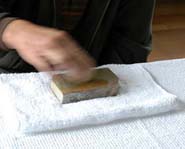
1・まるカ印の本山天然砥石に名倉砥を塗りつけます。名倉の粒子によって砥石の表面は粒度#6000くらい になります。
1. Create a light coating on your marukyu honyama stone with your nagura. With a nagura coating, the surface of your stone should be about #6000 grit.
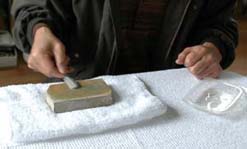
2・剃刀を片手持ちで手にもって砥石の表面にピッタリとあて八の字の一画目を書くように引いて研 ぎます。
2. Hold the razor in one hand and, keeping it firmly on the stone, make the first stroke of an "x". *though not mentioned, this should be the "omote" side.
3・次に裏側を八の字の二画目を書くように同じく剃刀を砥石の表面のピッタリと当てて研ぎます。
3. next, draw the second stroke of the "X" with the ura, in the same way as the first stroke. Keep the surface of the razor firmly on the hone.
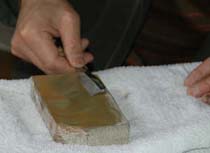
2,3を繰り返して行い砥石の研ぐ場所を変えて平に砥石が減るように気をつけて研ぎます。次第に研ぐそ(と ぎ汁)が細かくなり砥石の粒度が細かくなりま す。髪の毛で剃刀が切れるか調べます。毛が切れればよろしいです。
Repeat 2 and three, taking care to shift the honing area to avoid excessive wearing of your hone. As your slurry becomes less, the grit of your stone will become
smaller. Check the edge with the HHT. If it can cut a hair, it's ok.
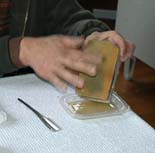
砥石を水で洗い研ぐそを洗い流します。
Wash the hone well with clean water.
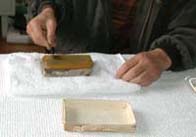
砥石の表面に綺麗な状態で2・3の方法で仕上げの研ぎを行います。
With a clean hone, repeat steps 2 and 3 to perform the final polish.
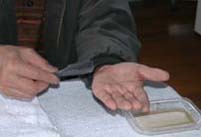
剃刀を手の平に軽くなでます。裏側も同様にして、むだ刃(刃の返り)が取れます。
Run the razor lightly over your palm. Do the same for the ura, and you will remove the burr.
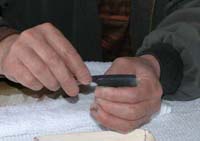 剃 刀に刃が付いたかどうか調べるには、髪の毛の毛根を上にして持ち、剃刀の重みだけで軽く毛が切れれば大丈夫 です(左図)。この方法は、理髪店のプロの方も 行う八の字研ぎです。剃刀に本刃がつきますと顔が剃れます。天然砥石がない場合は、#6000程度の砥石と セラミック砥石のシャプトン刃の黒幕クリーム仕 上砥#12000をお使い下さい。
剃 刀に刃が付いたかどうか調べるには、髪の毛の毛根を上にして持ち、剃刀の重みだけで軽く毛が切れれば大丈夫 です(左図)。この方法は、理髪店のプロの方も 行う八の字研ぎです。剃刀に本刃がつきますと顔が剃れます。天然砥石がない場合は、#6000程度の砥石と セラミック砥石のシャプトン刃の黒幕クリーム仕 上砥#12000をお使い下さい。
To check whether your razor has an edge or not, hold a hair with the root out and bring the razor down, using only the weight of the razor to cut the hair.
If the hair is cut, it's ok ( *Check the picture--he's doing the hht BLADE DOWN).
This method is used by professional barbers, along with the "X" pattern honing, If you have created a true edge, you can shave. If you don't have a natural whetstone, please use a 6000 grit hone and a ceramic Shapton "ha no kuromaku" cream 12000 finishing stone.
-
02-12-2009, 12:38 PM #23

I knew this one would be odd. Incomplete judging from the bevels of new I wasaki razor.
-
02-12-2009, 01:25 PM #24

Yeah, it did seem pretty incomplete to me...but it's the only other one I found. I took out some pictures to keep it inside the "7 image limit" but all of the text is intact.
One other odd thing...Why do I keep typing "rations" instead of "ratios"?
-
02-16-2009, 05:50 AM #25

OK, so poking around the interwebs I stumbled across this page. It appears to be a very, VERY detailed explanation of all things Kamisori, including diagrams, bevel setting theory, etc. But it's 19 pages long, and that's just a wee bit much for me to translate at the mo'.
Anyone up for a challenge?
-
01-20-2010, 03:44 AM #26is Over 9000!!!!

- Join Date
- Aug 2009
- Posts
- 679
Thanked: 326
Having re-read this, I didn't know Ryuichi-san honed using X-strokes.
Have any of you tried that method? If so, any noticeable differences?
Anyone translate the 19-page guide? Thanks
-
02-15-2010, 11:50 AM #27

OK, so I apparently TOTALLY screwed up that translation, and only know have the sharp eyes of a couple of our members caught it. I think it's not my fault, because I've never, ever done anything wrong in my entire life. Right?
Anyway, here are the culprits:

剃刀の裏、先端から5mmぐらいのところをしっかり押さえ、砥石にベタッと当てます。
Place the back (ura) of the razor flat on the stone and press firmly at a point about 5mm from the cutting edge.
and

表が研げれば、今度は裏面をベタッと当てて軽く研ぎます。
表7:裏3以下ぐらいで裏を研ぎます。
For the front (omote), this time hold the backside lightly and hone. Do not exceed a ratio of omote 7: ura 3 when honing the ura.
As any fool can plainly see (eventually, after several PMs ), the translated names and the pictures are bass ackwards. The first picture shows what we have all been calling the "Omote" flat against the stone, and the second picture shows the "Ura" against the stone. But the captions say the opposite.
), the translated names and the pictures are bass ackwards. The first picture shows what we have all been calling the "Omote" flat against the stone, and the second picture shows the "Ura" against the stone. But the captions say the opposite.
Now, the thing is, the names we've been using ("Ura=stamped" and "Omote=nonstamped") are backed up in several other very reputable sources I've seen, including a response I asked in an email from Ryuichi Mizuochi-san himself. ("Engraved side is the back" is how it was put. Back=ura in Japanese.).
So I'm looking at the first caption, and I can see how I got confused. It says, in Japanese, word for word, "Razor's Ura, at a place 5mm from the leading edge firmly press, on the hone flatly put." So, it could very well be saying press the Ura--meaning PUT YOUR FINGERS ON THE URA.
The second one I just plain screwed up. The verb is "When you have honed the Omote, this time hold the Ura flat (on the stone?) and lightly hone." Bad translation, and thank you guys for catching it.
Eventually.
Sorry about that dudes.
-
-
04-04-2010, 08:26 AM #28

Thanx Jim. Couldn't resist partial quote from "Life of Brian

" Now write it out 100 times & if it's not done by sunrise ..... The white gleam of swords, not the black ink of books, clears doubts and uncertainties and bleak outlooks.
The white gleam of swords, not the black ink of books, clears doubts and uncertainties and bleak outlooks.
-
The Following User Says Thank You to onimaru55 For This Useful Post:
RJS52 (11-08-2014)


 5Likes
5Likes LinkBack URL
LinkBack URL About LinkBacks
About LinkBacks









 Reply With Quote
Reply With Quote
